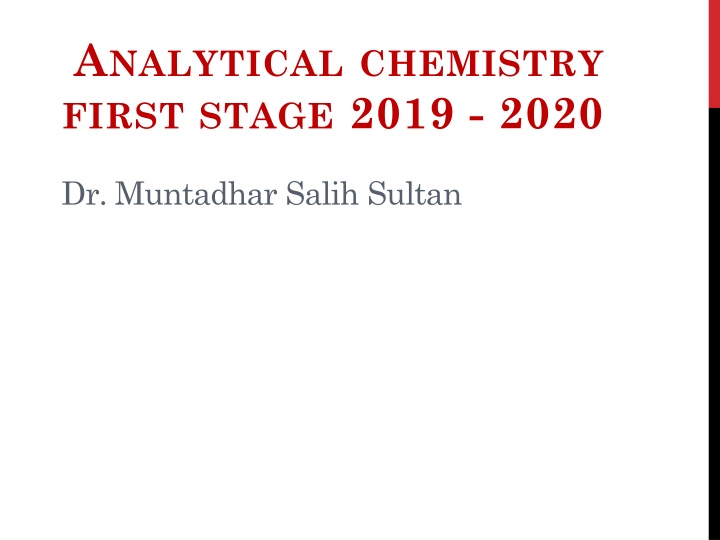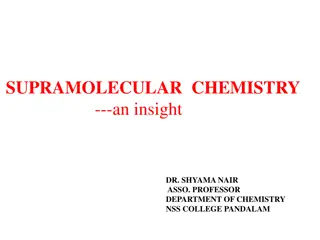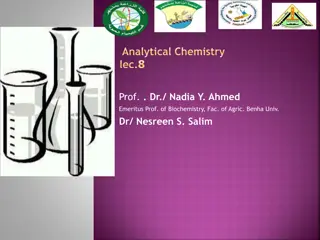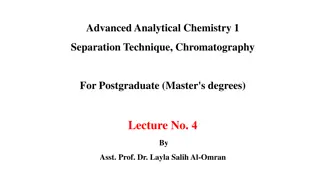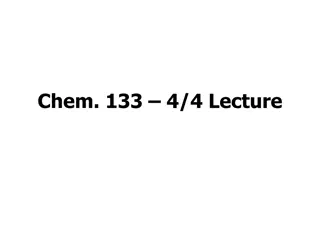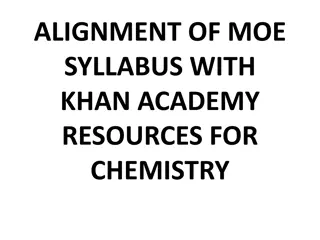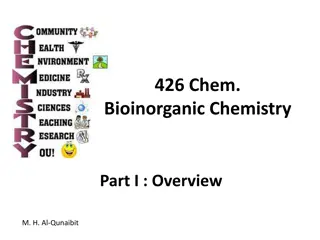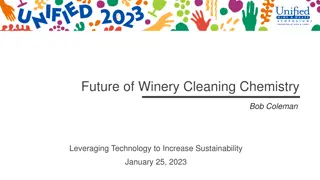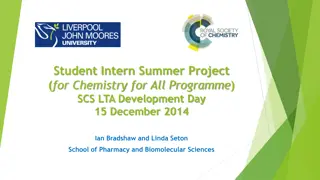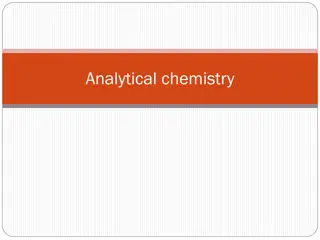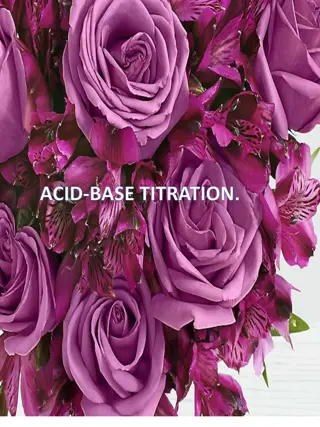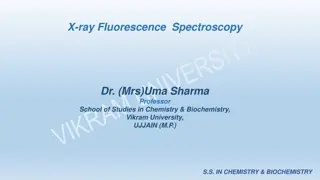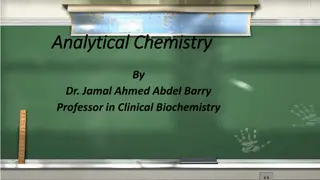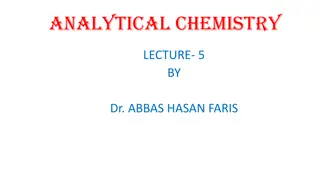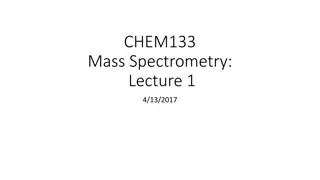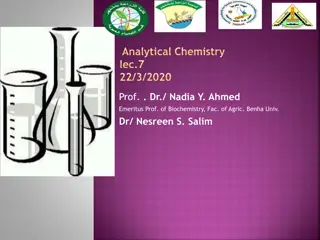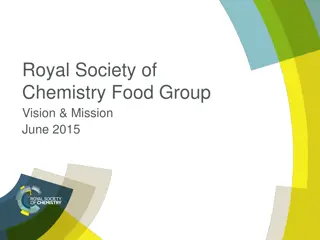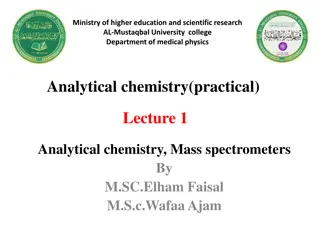ANALYTICAL CHEMISTRY FIRST STAGE 2019-2020
The process of precipitation in analytical chemistry involves nucleation and growth mechanisms, impacting particle size and crystalline suspensions. Additionally, digestion or Ostwald ripening affects crystal size and impurity coprecipitation.
Download Presentation

Please find below an Image/Link to download the presentation.
The content on the website is provided AS IS for your information and personal use only. It may not be sold, licensed, or shared on other websites without obtaining consent from the author.If you encounter any issues during the download, it is possible that the publisher has removed the file from their server.
You are allowed to download the files provided on this website for personal or commercial use, subject to the condition that they are used lawfully. All files are the property of their respective owners.
The content on the website is provided AS IS for your information and personal use only. It may not be sold, licensed, or shared on other websites without obtaining consent from the author.
E N D
Presentation Transcript
ANALYTICAL CHEMISTRY FIRST STAGE 2019 - 2020 Dr. Muntadhar Salih Sultan
Mechanism of Precipitate Formation The effect of relative supersaturation on particle size can be explained if we assume that precipitates form in two ways: by nucleation and by particle growth. The particle size of a freshly formed precipitate is determined by the mechanism that predominates. In nucleation, a few ions, atoms, or molecules (perhaps as few as four or five) come together to form a stable solid. Often, these nuclei form on the surface of suspended solid contaminants, such as dust particles. Further precipitation then is governed by the competition between additional nucleation and growth of existing nuclei (particle growth). If nucleation predominates
a precipitate containing a large number of small particles results, and if growth predominates, a smaller number of larger particles is produced. The rate of nucleation is believed to increase enormously with increasing relative supersaturation. In contrast, the rate of particle growth is only moderately enhanced by high relative supersaturation. Therefore, when a precipitate is formed at high relative supersaturation, nucleation is the major precipitation mechanism, and a large number of small particles is formed. At low relative supersaturations, on the other hand, the rate of particle growth tends to predominate, and deposition of solid on existing particles occurs rather than further nucleation. Low relative supersa- turation produces crystalline suspensions.
3. Digestion We know that very small crystals with a large specific surface area have a higher surface energy and a higher apparent solubility than large crystals. When a precipitate is allowed to stand in the presence of the mother liquor (the solution from which it was precipitated), the large crystals grow at the expense of the small ones. This process is called digestion, or Ostwald ripening, and is illustrated in following Figure :
Small particles have greater surface energy associated with a greater surface area and display somewhat greater solubility than larger particles. The small particles tend to dissolve and reprecipitate on the surfaces of the larger crystals. Impurities in precipitares. Precipitates tend to carry down from the solution other constituents that are normally soluble, causing the precipitate to become contaminated. This process is called coprecipitation. The process may be equilibrium based or kinetically controlled. There are a number of ways in which a foreign material may be coprecipitated.
A- Occlusion and Inclusion. In the process of occlusion, material that is not part of the crystal structure is trapped within a crystal. For example, water maybe trapped in pockets when AgNO3 crystals are formed, and this can be removed to a degree by dissolution and recrystallization. If such mechanical trapping occurs during a precipitation process, the water will contain dissolved impurities. Inclusion occurs when ions, generally of similar size and charge, are trapped within the crystal lattice (isomorphous inclusion, as with K+ in NH4MgPO4 precipitation). These are not equilibrium processes. Occluded or included impurities are difficult to remove. Digestion may help some but is not completely effective. The impurities cannot be removed by washing. Purification by dissolving and reprecipitating is helpful.
B-Surface Adsorption. As we have already mentioned, the surface of the precipitate will have a primary adsorbed layer of the lattice ions in excess. This results in surface adsorption, the most common form of contamination. For example, after barium sulfate is completely precipitated, the lattice ion in excess will be barium, and this will form the primary layer. The counter ion will be a foreign anion, say, nitrate two for each barium. The net effect then is an adsorbed layer of barium nitrate, an equilibrium-based process. These adsorbed layers can often be removed by washing, or they can be replaced by ions that are readily volatilized. Gelatinous precipitates troublesome, though. Digestion reduces the surface area and, therefore, the adsorbed amount. are especially
C- Post precipitation. Sometimes, when the precipitate is allowed to stand in contact with the mother liquor, a second substance will slowly form a precipitate with the precipitating reagent. This is called post precipitation. For example, when calcium oxalate is precipitated in the presence of magnesium ions, magnesium oxalate does not immediately precipitate because it tends to form supersaturated solutions. But it will precipitate if the solution is allowed to stand too long before being filtered. Similarly, copper sulfide will precipitate in acid solution in the presence of zinc ions without zinc sulfide being precipitated, but eventually zinc sulfide will precipitate. Post precipitation is a slow equilibrium process.
D- Mechanical Entrapment. Mechanical entrapment occurs when crystals lie close together during growth. Several crystals grow together and in so doing trap a portion of the solution in a tiny pocket. Both occlusion and mechanical entrapment are at a minimum when the rate of precipitate formation is low, that is, under conditions of low supersaturation. In addition, digestion often reduces the effects of these types of coprecipitation. Undoubtedly, the rapid dissolving and reprecipitation that occur at the elevated temperature of digestion open up the pockets and allow the impurities to escape into the solution.
